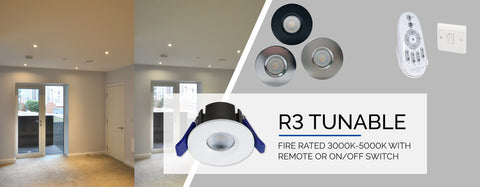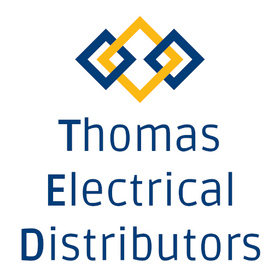LED Downlights - A Complete Guide
LED Downlights
In this article we will talk and explain everything you can possibly know about downlights. A downlight is a light fixture that is normally installed in the ceiling. They come in a variety of different types, shapes and sizes but no matter what, ultimately they are designed to provide light into a room. Not only can downlights be different in appearance they can also be known as different things such as recessed light, can lights or canister lights.
Downlights are a popular choice for lighting in Kitchens, bathrooms and commercial environments but due to their versatility more recently they are being used throughout a whole house. The improvement of technology and manufacturing means with the correct IP rating there are now outdoor downlights to give your garden a modern look!
Before we get to the LED technology and how its advanced over the last 5 years, let’s breakdown the fundamentals of what a downlight is:
Colour Temperature

Colour Temperature is an important factor when choosing any range of LED downlight. Until around 5 years ago you chose between warm white, cool white and daylight white.
Warm White (3000k) - Warm white is normally the best option for rooms within the house that are for comfort and relaxing. Such as, living rooms, lounges, bedrooms and traditional kitchens but the choice of colour is dependent on the decor of the home. Warm white has more of a yellow tone which is why it’s used predominantly in the more chilled out rooms. The colour of an LED used is different on a case by case basis and each individual has a different idea on how they would want their home to look, and so they should. How boring would life be if everyone chose the same decor, with the same lighting.
Cool White (4000k) - There is a whole spectrum of different variations of white, but by the casual eye they can be divided into cool white or warm white. As explained, warm white gives you a more yellow, warm tone. Cool white is the opposite, this gives you a fresh, crisp white light which is used in bright white rooms, kitchen and garages. This type of light is normally used in busier rooms within the home, where you cook or work.
Daylight White (5000k +) - At the opposite end of the lighting spectrum to warm white, you will find daylight white. As the name suggests this colour temperature is the closest to replicare natural daylight. Daylight white makes an ideal christmas lighting decoration but also will produce a vibrant and intense light. You will normally find this type of light in a make-up mirror, to give you that extra definition!
Nowadays, most LED Downlights are colour changeable. This means with a flick of the switch you can change between these three colour outputs. How ideal? For example with the JCC V50 downlight they can be installed and if you are not sure on the set colour temperature you quite simply pop the front bezel off and flick a switch to change colour. The location of the colour change switch varies between manufacturers, some are on top of the downlight which is located in the ceiling.
Wattage and Lumens
As important as colour temperature, the brightness of course is a huge factor when deciding on what led downlight to choose. The brightness can make a big difference to the look and feel of a room when you walk in.
The common assumption is the higher the wattage the brighter the light. This is not true and there is no relation to wattage and brightness. Wattage is actually just telling you how much power goes into the downlight and how much energy it uses. Lumens (lm) are what you need to be looking for, this is the measurement of light visible to the human eye.
On average most domestic lights have a lumen count of anywhere between 250-850 lumens. But if you look at lighting on an industrial scale there are smaller lights that emit only 100 lumens and then there are large commercial floodlights that can be anywhere up to 25,000 lumens!
To calculate the amount of lumens a light gives can be difficult but there have been many studies to see how accurate they are. Through these investigations it was found that a directional light for example a downlight the lumen output is much more accurate due to the light being directed in one direction. Whereas a golfball lamp or a standard bulb in a pendant gives light in many directions so is harder to calculate.
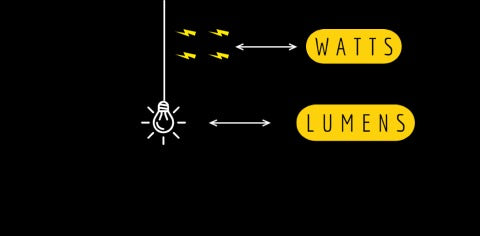
How many Lumens do I need?
Put quite simply, there is no definitive answer. The result changes for every single room as it will depend on room size, shape, colour scheme, height of ceilings and of course the type of room.
As a basic guide these are the recommendations.
Kitchen Lighting - 300-500 Lumens
Living Room Lighting - 400-500 Lumens
Hallway Lighting - 300 Lumens
Bedroom Lighting - 300-400 Lumens
Bathroom Lighting - 500-700 Lumens
Reading Lighting - 400 Lumens
These calculations are by no means exactly what you need, as explained the requirements for lumens are different in every scenario but this is a rough guide.
Bezel / Trim
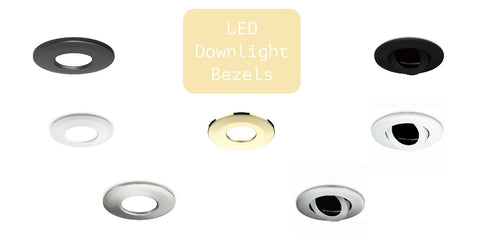
The bezel is the most important part of the downlight for the homeowner, as it’s the only component that you will see once the downlight is installed. The bezel will not impact the performance of the light, it is a personal preference to suit your home.
Downlight bezels come in a huge variety of finishes from white all the way through to antique brass. From our experience white bezels are the most popular choice, this will be down to the colour blends in naturally with most ceilings.
Placement
Where you install your downlights is vital for their performance and the overall finished look of your room. Placing led downlights too close together will result in inconsistent lighting or an odd look when they are on.
When you are planning out the placement of your downlights you need to make sure they are evenly spaced downlights across the room. Our recommendation is to position between 1 and two foot away from walls, and make sure there is a 3 to 4 feet gap between each downlight.
Within the industry the most common way of working out the placement of your downlights is to divide the ceiling height by two, this will then gauge how much space you need to leave between each downlight. For example, if your ceiling height is 10 feet, your lights should be 5 feet apart.
Beam Angle
The majority of LED Downlights come with a 40 degree beam angle, anything within 5 degrees of this is classed as standard within the lighting industry. If you were to select a downlight with a larger beam angle does not mean you get any extra light, it just expands the light output further across the space. The brightness which we know now is measured in Lumens remains exactly the same but the beam intensity increases, this is measured in candelas.
The downside to choosing a wider beamed light is you have a lower intensity brightness. The best and most simple was to look at beam angle is between two different types:
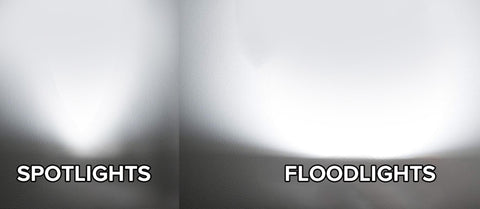
Fire Rated Downlights
When a house is built all floors and ceilings will have passed a fire test as a complete structure. When a downlight is installed, it compromises the once safety tested fire barrier. Older style downlights were not designed with fire safety in mind, they had an open back which would allow fire and heat to penetrate the floor space. This could cause a potential collapse before the required time of 30, 60 or 90 minutes.
This is where a fire rated downlight becomes an essential requirement. Fire rated downlights use a sealed steel body, they also have an exterior intumescent strip around the light. In the case of a fire breaking out, these described elements separate the room from the ceiling void. This will slow the spread of the fire, which is vital.
The majority of downlights manufactured within the UK are made to meet the strict and important british standards, such as;
- BS 476: Part 21: 1987 - Fire test on building materials and structures. This will determine the fire resistance in elements of construction
- BS EN 1365-2: 2014 - Fire Resistance tests. Floors and Roofs.
- BS EN 1363-1: 2012 - General Requirements, Fire resistance Tests.
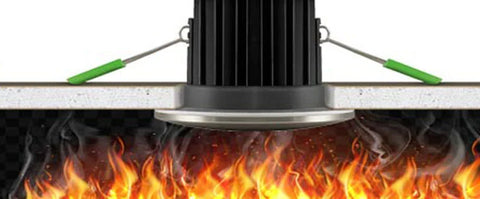
Do Downlights have to be fire rated?
In short, no. Downlights don’t have to be fire rated as it will depend on the overall construction of the property and the ceiling they will be installed in. Although we would recommend that all downlights you consider are fire rated. This is because it is simply another protection measure to keep you and your home safe.
The benefits of installing fire rated downlights far outweigh the difference in price they are in comparison to the non fire rated versions. You can add a firehood to non fire rated downlights, but the cost of this brings them in line with fire rated versions.
Our TrusTED Picks
JCC V50 Colour Selectable LED Downlight
The JCC V50 is a high performance colour selectable LED downlight. The technology within this downlight is outstanding, you can switch seamlessly between warm white and cool white. All you need to do is unclip the front bezel and flick the switch to the other colour.
The many other impressive features of this downlight range is they are fire rated, insulation coverable, dimmable and IP65 rated. This IP rating means the fitting is protected from jets of water from all angles, but this doesn’t mean they are completely waterproof. They cannot be submerged in water, this seems obvious but important to know just in case!
For the electrical contractor, JCC has designed this downlight to be robust, quality and quick to install. The wiring is made easy with a push fit, loop in and loop out connector block.
The V50 also has a 2 year standard warranty that extends to a 3 year commercial warranty or 5 year domestic warranty when registered within the first year of purchase with JCC.

Kosnic Mauna Dimmable LED Downlight
The Kosnic Mauna downlight range are fire rated, and is suitable for 30, 60 and 90 minute applications and can be installed underneath insulation. They are built to be compact, easy to install and can be dimmed with a main dimmer switch.
This downlight has proved to be increasingly popular in retail shops, hotels and kitchens. This will be due to their fantastic build quality and their durability.
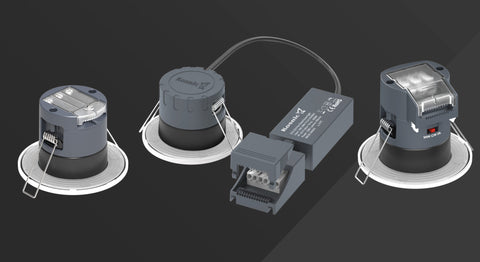
Ricoman R3 All in One LED Downlight
The Ricoman R3 LED Downlight is a great option for end users who want to control their downlights through a remote controller! Although the remote controller needs to be ordered separately.
Colour temperature switching technology is becoming more popular every single year as mentioned in the above colour section. All rooms are used for different functions, so why shouldn't lighting colour be thought of in the same way!
Put aside this downlight is remote controllable, another stand out feature is its extremely low profile design, just 63mm!
